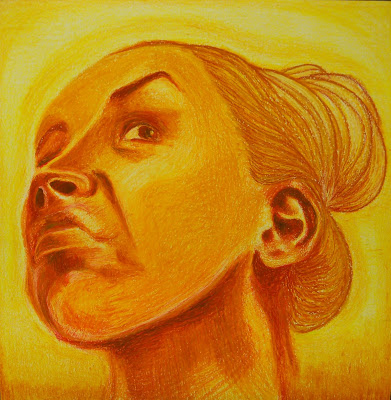




 Arrogance
Arrogance Rage
Rage Drawing for print
Drawing for print
I'm happy. I don't usually find good use for backgrounds. I think they are distracting. I feel the same way about titles. In this case, however, the background played in important role in serving as a representation of the boundary between reason and passion. Since I believe that man is transported into a realm of disorder when enraged, I thought it would be appropriate to depict the face physically emerging through a wall.
This one took 20 cumulative hours. I experienced major issues with the solid layer. I worked with fairly loose ink-- the viscosity was where it was supposed to be. Despite that, I was seeing lap marks, or annoying lines on the paper that mark where the roller starts and stops. I ended up using a roller with a large diameter--a good 8-10". With that, all problems were solved. I went from doing 5 drops to just a double drop.
 Envy
Envy
 Paranoia
Paranoia.JPG)
.JPG) Get To Work
Get To Work
The person who purchased this series expressed to me that the image provided that relief for her, also. This series of prints and it's production fueled my passion for printmaking-- or generally, making art. There is something very special about being able to create a work of art that evokes a powerful emotion not only in the artist but in the audience. I really hope I can continue doing that for a long time.
.JPG)
I've been drawing my face ever since I could. It's not egotism, it's just that I'm the most willing and accessible model I know. I don't like to bother people or make them feel like they are a model. They get nervous and start thinking about what they are doing and how they look. I'll draw people when they are not watching but you can only accomplish so much using that method. For realistic representations I need more time and more stillness..JPG)
Graphite on Paper
8.5" x 11"
2006
Gasp!
Colored Pencil on Paper
18" x 24"
2005
.JPG)
The image of the human figure can be a very powerful thing. I have always been interested in the human figure-- the form in itself is amazing to me. These works were produced in a Human Figure course I took. Most of the following images are purely academic excercises for the purpose of simple rendering practice.
.JPG)
.JPG)
.JPG)
.JPG)
.JPG)
Infant 2
Graphite on Paper
8.5" x 11"
2004
Infant 3
Graphite on Paper
8.5" x 11"
2004
.JPG)
.jpg)
.JPG)